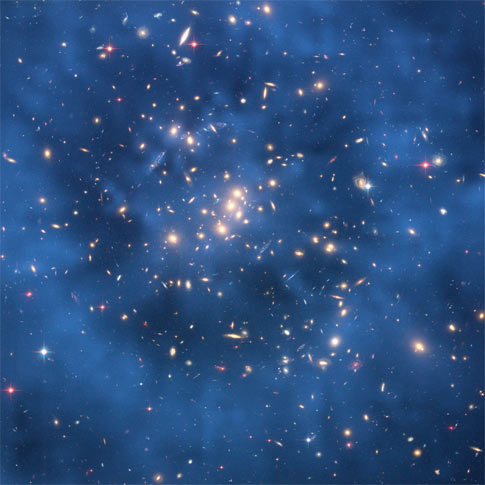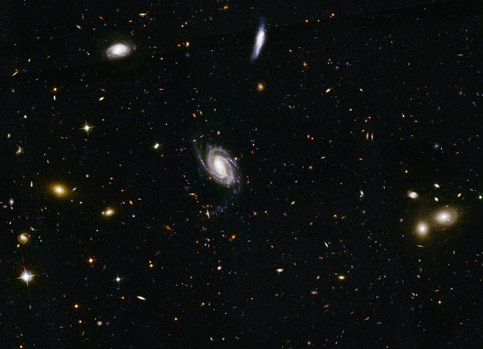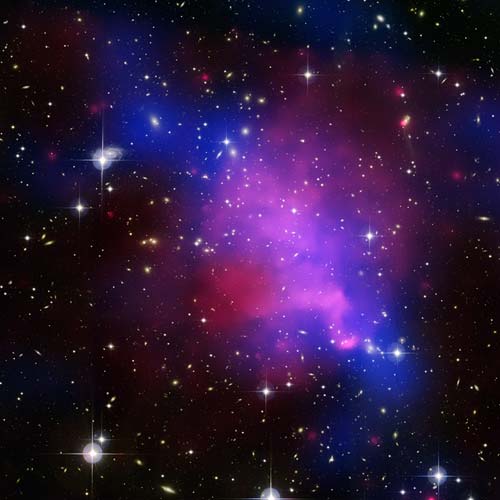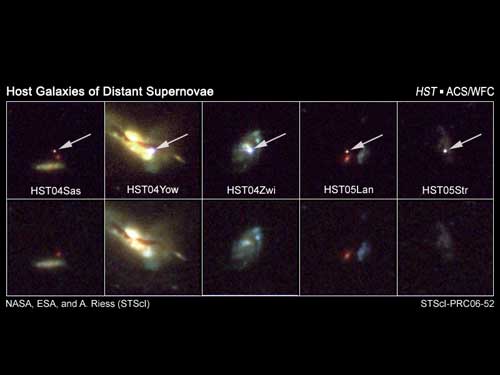Hubble finds dark matter smoke ring
Posted at 9:01 am in Pretty pictures, NASA, Astronomy, Science, Cool stuff
I wont waste your time by first writing a lot of words. Lets get right to the way cool picture:

That image is of the galaxy cluster CL0024+1652 (go look at the higher resolution version its very pretty!), a galactic city located a whopping 5 billion light years away! That means the light we see from this cluster left it five billion years ago, so were seeing this structure as it was when the Universe was just 2/3 its present age. Almost every small object in that image is a galaxy, and all of them are held sway by the clusters gravity, orbiting the center like bees flying around a beehive.
It has long been thought that every large object in the Universe is surrounded by a halo of dark matter unseen, mysterious, yet profoundly influential in the life of normal matter. Dark matter (or just DM for short) gives off no light, and does not interact with normal matter directly a cloud of it could pass right through you and youd never know. But, like regular old matter, it has gravity, and that can betray its presence.
Ive gone over this before Einstein postulated that gravity from matter bends space, like a bowling ball on a bed bends the mattress. Light will follow that bend in space the same way a marble rolled across the bed will curve from the bowling balls dip. If there is some massive object out there in space, and some galaxy beyond it, the light from the more distant galaxy will bend as it passes by the intervening material. We see that as a distortion in the shape of the galaxy. This is called gravitational lensing, and can be used to map out the location of dark matter. So even though we cannot see DM directly, we can see its effects.
<snip>
This ring will prove important to astronomers for many reasons. For one, it gives us insight on how dark matter can be shaped by normal matter. We dont understand the nature of DM very well at all, so anything like this can only be helpful in honing the theories. For another, this is a bright, dense, well-observed cluster, so we can learn quite a bit about it. The more we understand the cluster, the less we have to guess about its DM halo. For a third, this is the first time a halo of DM has been seen to be so differently shaped from the gas and other mass in the cluster. It can be studied separately from the normal matter, making that task in some ways easier.
More:
http://www.badastronomy.com/bablog/2007/05/15/hubble-finds-dark-matter-smoke-ring/AAS Report #2: Dark matter and large scale structure
Posted at 5:37 pm in Pretty pictures, NASA, Astronomy, Science, Cool stuff
A note: I am attending a meeting of the American Astronomical Society in Seattle. I will blog as much as I can from this meeting, as there is a LOT of news coming out, as well as lots of fun and wonderful scientific geekiness. This particular blog entry is a bit long as I have to explain some relatively complex things to get to the point. I think most of my reporting will be somewhat less wordy. But no promises! I love this stuff, and I love to talk about it.
Heres a (very) small piece of the survey image from Hubble:

<snip>
But a trick of relativity winds up betraying the presence of dark matter, too. As Einstein postulated, matter bends space, the way a heavy weight in a bed will warp the mattress. Light traveling though empty space will move in a straight line, but if matter is warping space, light will travel along the bent space as well. Imagine light from a distant galaxy is on its way to us. But between this galaxy and us is some large mass, like a clump of dark matter. The light from the galaxy will bend around the matter, and when it gets to us it will be slightly distorted, just as if the light has passed through a lens. This process, in fact, is called gravitational lensing (for more about this, see my writeup about the Bullet Cluster, image #4 in my Top 10 Images of 2006).
So astronomers can map out the location of dark matter by very carefully taking observations of large areas of the sky and painstakingly teasing out the distortions in the shapes of background galaxies. The observations need to be done from space because the background objects are faint, small, and very close together. Space-based telescopes can more easily see fainter objects than ground-based scopes, and have better resolution they can separate closely spaced objects better. Thats why Hubble was used for this survey. In fact, the survey was massive: it took 10% of Hubbles time over two years. Its the biggest single project ever done by Hubble.
But Hubble has limitations. To get the dark matter location, the distances to many thousands of galaxies had to be found. This was done from the ground, using the Very Large Telescope and the Subaru Observatory, using a technique called photometric redshift. Basically, the galaxies were observed through many different color filters, and the brightness of a given galaxy in each filter can be used to determine its distance.
More:
http://www.badastronomy.com/bablog/2007/01/07/aas-report-2-dark-matter-and-large-scale-structure/A dark hole
Posted at 12:37 pm in Pretty pictures, NASA, Astronomy, Cool stuff
Dark matter is pretty weird stuff. Weve seen tons of evidence for it: the way galaxies behave in clusters, the way individual galaxies rotate, and just in the past year two monster pieces of evidence supporting it were found (the Bullet Cluster (#4 on that list) and the COSMOS survey).
The deal is, dark matter doesnt interact with normal matter except through gravity. Two clouds of DM could pass right through each other and not collide like normal matter, but their mutual gravity might distort the shapes of the clouds. Dark matter also appears to hang out in giant clouds surrounding galaxies, and in theory may be the seed which helped cause galaxies and clusters to form in the first place.
The evidence for this has been really good
but then a monkey got thrown in the wrench.

The image above was just released, and shows an optical image of galaxy cluster Abell 520 with an X-ray image from the orbiting Chandra X-ray observatory overlaid on it. The optical image shows stars in our Milky Way and galaxies belonging to the cluster. The red fuzz is hot gas made of normal matter, heated to millions of degrees in the cluster. The blue fuzz is the location of the dark matter in the cluster, inferred by its effect on the light of background galaxies (I describe how this is done in detail here).
The problem is, where there appears to be the most dark matter, near the center of the cluster, there are very few galaxies. And there are areas where there are lots of galaxies, but little dark matter. This is the opposite of what the theory predicts! In general, the DM and the galaxies should stick together, so wherever you see one you should find the other.
More:
http://www.badastronomy.com/bablog/2007/08/16/a-dark-hole/Further Information on Dark Energy
by Clifford, at 11:26 am, November 16th, 2006 in science, science in the media, astronomy, cosmology, dark energy
So the press conference is over. I did not listen to it, but the gist of it, from the press release, seems to be that theyve observed several more supernovae to pin down even more accurately what the universes expansion rate was at very early times (up to nine or ten billion years ago). Image below from their site:

From the site, we learn (for background):
Astronomers used the supernovae to measure the expansion rate of the universe and determine how the expansion rate is affected by the repulsive push of dark energy, a mysterious energy force that pervades space. Supernovae provide reliable measurements because their intrinsic brightness is well understood. They are therefore reliable distance markers, allowing astronomers to determine how far away they are from Earth.
From the press release (what came before):
Previous Hubble observations of the most distant supernovae known revealed that the early universe was dominated by matter whose gravity was slowing down the universes expansion rate, like a ball rolling up a slight incline. The observations also confirmed that the expansion rate of the cosmos began speeding up about five to six billion years ago. That is when astronomers believe that dark energys repulsive force overtook gravitys attractive grip.
The new crop of supernovae tell us about quite a bit earlier
. nine or ten billion years
. From looking at them, they find evidence that Dark Energy was playing a role at that time too, still a repulsive component to the story, which is certainly good to know.
More:
http://asymptotia.com/2006/11/16/further-information-on-dark-energy/